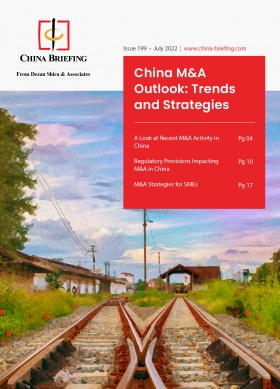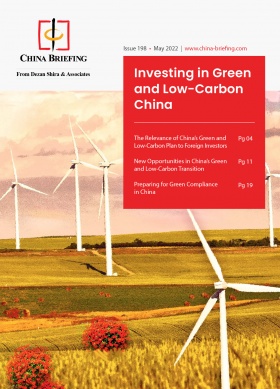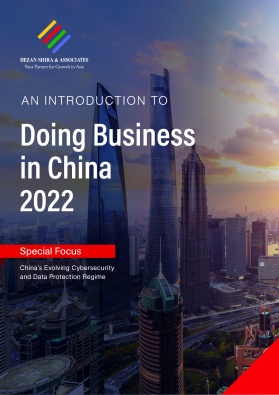AI in China: Regulations, Market Opportunities, Challenges for Investors
We discuss the evolution of AI in China, including market expansion and tech innovation, incentives, and challenges for foreign stakeholders.
The evolution of artificial intelligence (AI) presents numerous opportunities for businesses and organizations. In recent years, China has accelerated the development of AI-related technologies and capacities. The AI sector is a highly competitive field as major economies seek to lead the advancement of AI to the next level. In this article, we analyze the latest developments in China’s AI industry and examine the impact of recent US restrictions on the sector.
China’s AI market at a glance
As of 2021, China’s AI market was worth about RMB 150 billion (US$23.196 billion), and the figure is projected to reach RMB 400 billion (US$61.855 billion) by 2025, according to iMedia Research. By 2030, the Chinese government aims for the AI industry to create RMB 1 trillion (US$154.638 billion) worth of annual revenues, and have related industries generating RMB 10 trillion (US$1.546 trillion) annually.
AI technology, with its broad applications in industrial processes, medical research, autonomous vehicles, etc., may bring US$600 billion (RMB 4.3 trillion) annually for China’s economy, according to a report from McKinsey. This prospective value will equal to around 3.7 percent of China’s current GDP. Additional investment will be needed to unlock this windfall. In 2021, AI start-ups in China obtained US$17 billion (RMB 121 billion) in funding from private equity and venture capital investments, representing nearly one-fifth of the global total. Investments are required on multiple fronts, including the data and technologies to underpin AI systems, the right talent to build the systems, as well as new business models, industry standards, and partnerships to create data ecosystems.
China’s regulatory development on AI technology
China has taken the lead in designing AI regulations. The country has a number of broader schemes in place to stimulate the development of the AI industry, such as Made in China 2025, the Action Outline for Promoting the Development of Big Data (2015), the Next Generation Artificial Intelligence Development Plan (2017). In recent years, China has also fastened the pace to promulgate specific policies to regulate AI, regarding industry ethics and algorithms.
| Time | Title | Main publishing authority | Key provisions |
| July 2021 | ‘Trustworthy AI’ white paper | China Academy of Information and Communications Technology | The white paper describes the importance and difficulty of improving the “trustworthiness” of AI systems. It recommends increased use of methods such as federated learning and differential privacy to strengthen AI systems’ capability to withstand cyberattacks. The white paper’s policy recommendations include drafting more Chinese legislation related to trustworthy AI, developing commercial AI insurance policies, and taking a cautious approach to research on artificial general intelligence (AGI). |
| September 2021 | Ethical Norms for New Generation Artificial Intelligence | Ministry of Science and Technology | The document lays out ethical norms for the use of AI in China. The norms cover areas such as the use and protection of personal information, human control over and responsibility for AI, and the avoidance of AI-related monopolies. |
| September 2021 | Guiding Opinions on Strengthening Overall Governance of Internet Information Service Algorithms (关于加强互联网信息服务算法综合治理的指导意见) | Cyberspace Administration of China (CAC) | This document recommends strengthening the overall governance of internet information service algorithms and stimulating the healthy development of the sector. The Opinions focus on strengthening the security governance of internet information service algorithms with accountable management and use of algorithms. |
| March 2022 | Internet Information Service Algorithmic Recommendation Management Provisions | Cyberspace Administration of China (CAC) | The regulation governs companies’ use of algorithms in online recommendation systems, requiring that such services are moral, ethical, accountable, transparent, and disseminate positive energy. The regulation mandates companies notify users when an AI algorithm is playing a role in determining which information to display to them and give users the option to opt out of being targeted. Additionally, the regulation prohibits algorithms that use personal data to offer different prices to consumers. |
| March 2022 | Guiding Opinions on Strengthening Ethical Governance of Science and Technology | Ministry of Science and Technology | The document aims to improve the ethical system of science and technology, enhance governance, effectively prevent and control the ethical risks, and promote societal benefits. |
Chinese regulators implemented strict scrutiny of the country’s biggest tech companies, increasing oversight of data security and overseas listing policies. While the technology sector is still recovering from the impact of the crackdown since two years ago, some regulatory easing has been reported. Now facing more severe competition in the world, China looks again to its tech sector for more leverage.
Progress in Shenzhen: China’s first city-level AI regulation
On September 6, 2022, the Shenzhen government passed China’s first local regulation dedicated to boost AI development – Regulations on Promoting artificial Intelligence Industry in Shenzhen Special Economic Zone (the Shenzhen AI Regulation), which will take effect on November 1, 2022.
The Shenzhen AI Regulation aims to promote the AI industry by encouraging governmental organizations to be the forerunners in utilizing related technology and increasing financial support for AI research in the city. It also establishes guidelines for public data sharing to organizations and businesses involved in the sector.
According to the Shenzhen AI Regulation, Shenzhen-based AI services and products that are assessed as “low risk” can go for testing and trials even in the absence of local and national norms, if they adhere to international standards. The risk classification and management guidelines will be developed by the Shenzhen government separately. This risk-based management will facilitate innovation in the sector.
The Shenzhen AI Regulation also calls for the establishment of an AI ethics council, which will develop safety standards and examine how the technology will affect things like employment, data protection, and other societal concerns.
Currently, Shenzhen, home to many tech giants and AI-related businesses, is stepping up efforts to grow its high-tech sector. To pursue its goal of becoming China’s AI and tech powerhouse, Shenzhen is poised to invest more than RMB 700 billion (US$108 billion) in hi-tech research and development during 2021 to 2025.
Progress in Shanghai: China’s first provincial-level regulation for AI development
Similarly, Shanghai has also accelerated its pace in developing its AI sector. The city’s AI industry scale has expanded significantly in the past few years. In 2021, the combined output value of Shanghai’s AI enterprises above the designated size (reached RMB 305.68 billion (US$42.73 billion), according to China Securities Journal. The number of talented professionals working in the AI field has soared from 100,000 in 2018 to 230,000 in 2021 in Shanghai. AI is one of the three leading industries that Shanghai seeks to develop with concentrated efforts, along with integrated circuits and biomedicine.
On September 22, 2022, Shanghai passed China’s first provincial-level law covering AI development, Shanghai Regulations on Promoting the Development of the AI Industry (the Shanghai AI Regulation), effective from October 1, 2022. The Shanghai AI Regulation seeks to promote innovation and breakthroughs by developing core AI industries and strengthening the agglomeration of AI enterprises. The Shanghai AI Regulation will further pave the way for sound and sustainable development of the AI technology through a grading management and “sandbox” supervision – as mentioned in the regulation, these two management approaches aim to provide sufficient space for companies to explore and test out their technologies.
One highlight of the Shanghai AI Regulation is that it stipulates a certain degree of tolerance for minor infractions to encourage exploration of scientific frontiers and inspiring innovation. The rationale is that the AI field is unknown waters, and this “disclaimer” clause can ensure certain space for trials and testing, adding to institutional inclusiveness and flexibility. Relevant municipal departments can draw up lists of these infraction behaviors, indicating that there would be no administrative punishment for minor violations.
The Shanghai AI Regulation also clarifies bottom lines and ethical norms for the industry’s development by setting up an ethics council. Entities that carry out AI-related research and development and applications should abide by laws and regulations, while enhancing ethical awareness, to ensure the sound and safe development of the industry.
AI applications in China
Self-driving cars
Shenzhen has also made headlines by bringing in regulations on autonomous vehicles (AV) in China on August 1, 2022. Registered AVs are now allowed to operate without a driver in the driving seat across a broad swath of the city, but a driver must still be present in the vehicle. Shenzhen’s regulations provide a crucial framework for liability in the event of an accident. Once again, the city is a forerunner of the autonomous vehicles sector by generating RMB 106.6 billion (US$14.82 billion) with more than 1200 enterprises in 2021. Its goal is to yield a total revenue of RMB 200 billion by 2025.
One week later, China’s Ministry of Transportation listed drafted rules for public opinions to regulate the self-driving industry on August 8. The ministry encouraged the use of autonomous vehicles in passenger transport with care. On September 22, a proposal for autonomous driving test scenarios initiated by China has been formally accepted by the International Organization for Standardization (ISO), according to the Ministry of Industry and Information Technology. China may soon enter a new era in AV technology.
In 2021, China implemented its first national standards for grading autonomous driving. The country’s Taxonomy of Driving Automation for Vehicles provides official definitions for self-driving cars. Chinese cities have allowed robo-taxis to operate in restricted areas with permission of local authorities.
Robotics
China is rapidly emerging as a global power in robotics as the government aspires for the industry to compete with the world’s most innovative economies. By embracing more robots, China’s factories can keep costs down, making it less advantageous for companies to shift production to other emerging markets or their own home countries. According to a report from the Chinese Institute of Electronics (CIE), China’s robotics industry was worth RMB 83.9 billion (US$12.12 billion) in 2021. Of this, industrial robots were worth RMB 44.6 billion (US$6.44 billion), while service robots were worth RMB 39.3 billion (US$5.68 billion).
The Chinese government has been accelerating to upgrade its robotics industry. On December 28, 2021, the MIIT, alongside a number of other departments, jointly released the latest Five-Year Plan for the industry both strengthen China’s role as a manufacturer of robots and increase the application of such robots. By 2025, the plan states that China should become a global source of innovation in robotics and make breakthroughs in core robotics technology and high-end robotics products. By 2035, China’s robotics should be among the world’s best, and robots should be integrated in the economic development, daily lives, and social governance of China.
Challenges to China’s AI development: Access to advanced technologies
China and the US are in a race to increase respective commercial and technical comparativeness in AI. The US has imposed a series of export restrictions that could hit China’ AI industry, which still relies on foreign chips to a certain extent. On September 1, 2022, the US cut off the flow of advanced technology to China by instructing Nvidia Corp and Advanced Micro Devices (AMD) to stop sending their flagship AI chips there. The regulations focus on graphic processing units (GPU) with the most powerful computing capabilities. Products affected are Nvidia’s A100 and H100 chips and AMD’s MI250 chip while less powerful ones are not affected.
Most recently on October 7, 2022, the Biden administration rolled out a new round of policies, further curbing chip exports to China. More specifically, the new rule will block the shipment of components, advanced chips, and tools that China could use for manufacturing chips to China. The new rules also restrict the service and maintenance supports that are vital to keeping advanced chip equipment running smoothly. Additionally, 31 Chinese entities will be also added to the unverified list.
China’s AI industry still depends heavily on advanced chips produced in the US to conduct computing activities. As China’s technology and manufacturing capabilities still lag behind, increasing tensions with the US have raised concerns in both technology and commercial development. A record number of Chinese chip firms have also gone out of business. As many as 3,470 firms have closed since January, including those using the word ‘chip’ in their brands or operations. In August, chip exports from China plummeted by nearly a quarter, the biggest monthly drop since records began in 1997. These new rounds of export restrictions will give a massive blow to China’s AI development.
How can businesses cope with the situation?
The domestic and international marketplaces have delivered mixed information. Facing growing uncertainties, particularly given the international competition, investors are suggested to remain agile and keep multifold strategies in place. While the export bans may take some time to be in effect, companies can make efforts to stockpile chips to maintain enough reserves. Meanwhile, it will also be helpful to get familiarized with China’s domestic technologies and explore alternative supply chain options as early as possible.
On the other hand, China’s AI industry is a priority area for development and growing rapidly. Restrictions will motivate China to invest more assertively and to increase the pace towards self-sufficiency. While China lacks certain software and equipment capabilities for advanced AI, the environment remains open for foreign investment and talent. Companies must adapt to the changing business and political climate or will likely face decline or closure. Taking full advantage of China’s supportive policies, companies can adjust their business strategies to put more investment in R&D and talent. The AI industry is still promising in China with space for businesses development and scalable enterprise, alongside a host of incentives for R&D innovation.
About Us
China Briefing is written and produced by Dezan Shira & Associates. The practice assists foreign investors into China and has done so since 1992 through offices in Beijing, Tianjin, Dalian, Qingdao, Shanghai, Hangzhou, Ningbo, Suzhou, Guangzhou, Dongguan, Zhongshan, Shenzhen, and Hong Kong. Please contact the firm for assistance in China at china@dezshira.com.
Dezan Shira & Associates has offices in Vietnam, Indonesia, Singapore, United States, Germany, Italy, India, and Russia, in addition to our trade research facilities along the Belt & Road Initiative. We also have partner firms assisting foreign investors in The Philippines, Malaysia, Thailand, Bangladesh.
- Previous Article China Relaxes Provisions on Foreign-Invested Travel Agencies and Care Homes
- Next Article Tax, Accounting, and Audit in China 2022/23 – New Publication from China Briefing







